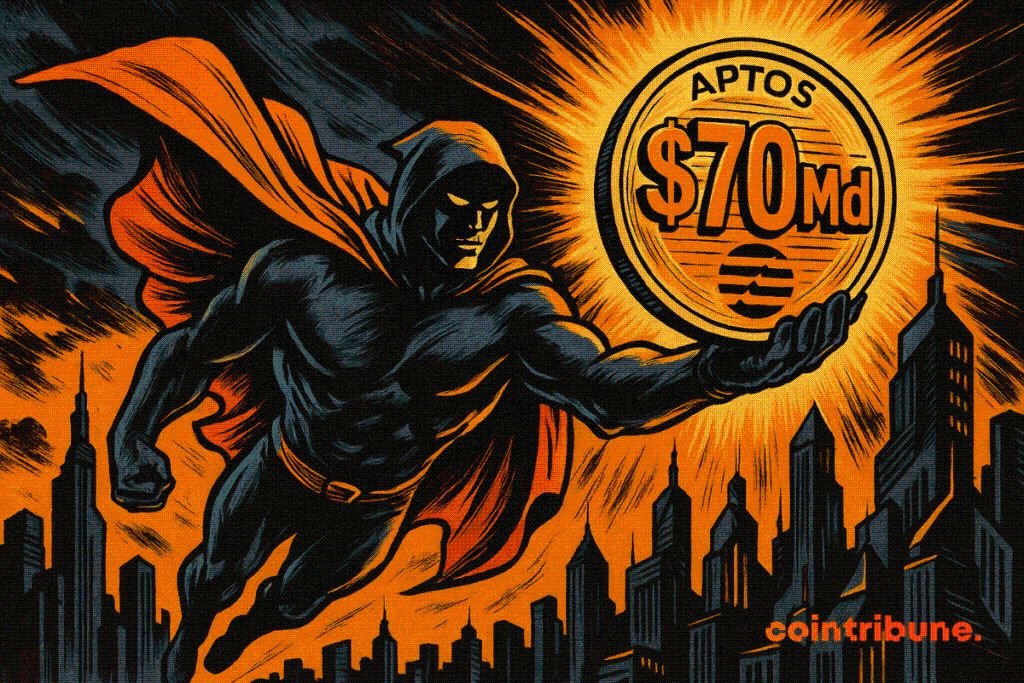Aave Deploys $70B on Aptos to Tap Stablecoin Liquidity
The boom of stablecoins and the crypto industry breathed a contrastive and lively breath. To some speculative frenzy responds the quest for efficiency of others. Amid this turmoil, Aave advances by leaps and bounds. Backed by $70 billion in aggregated deposits, the protocol expands its territory on Aptos, a non-EVM blockchain designed for performance. A disruptive strategy, designed to chase speed, security, and new liquidity flows all at once. A new chapter of DeFi is being written, between institutional ambitions and technical pragmatism.

In brief
- Aave lands on Aptos with a rewritten version in Move, a native non-EVM language.
- The protocol secures its launch with audits, contests, and a 500,000 GHO bug bounty.
- Stablecoin TVL on Aptos jumps to $1.27B, Aave becomes a growth catalyst.
- By partnering with WYST, Aave targets RWAs and $1.5 trillion in tokenized finance.
When “Move” replaces Solidity: Aave reprograms its future on Aptos
After breaking all records with $50 billion in net deposits in mid-July , Aave makes waves again. Its arrival on Aptos is not just a move, it’s a change of grammar. No EVM here: the protocol had to rewrite all its code in the Move language, tailored for Aptos’s virtual machine. This overhaul gives birth to a fluid, native Aave, perfectly suited to the chain’s promises.
On the performance side, Aptos announces up to 150,000 transactions per second, negligible fees, and almost instant finality. A boon for demanding DeFi applications.
But there’s no rush: audits have multiplied, a ‘Capture The Flag’ contest was organized with Cantina, and a 500,000 GHO bug bounty was launched. Security researchers were involved from the start, allowing the team to cultivate its ‘security first’ approach — always at the core of Aave’s development, according to an official statement from the Aave team.
This method shows an almost obsessive concern: to do things properly, to inspire confidence.
Multi-chain crypto: Aave dreams of becoming a liquidity aggregator
Fragmentation is DeFi’s sworn enemy. Each chain isolates its markets, users, and TVL. Aave wants to break this pattern. By settling on Aptos, one of the few grounds not saturated by DeFi giants, the protocol plays a bold move. And the first figures confirm the bet: by 2025, stablecoin TVL on Aptos has doubled, rising from $628M to $1.27B.
On Arbitrum, Aave’s arrival had made the TVL leap from $1.2 billion to $4.8 billion in six months. If this scenario repeats, Aptos could experience a similar rise. And this cross-chain expansion could make Aave the Google Translate of crypto liquidity.
As Aave’s spokesperson points out:
By expanding to Aptos, Aave increases access to lending, borrowing, and savings to a new, fast-growing community
For Aave, it’s as much a mission as an opportunity.
$1.5 trillion in sight: Aave targets institutions
In this new playground, Aave no longer speaks only to crypto aficionados. With Aptos integrated into the WYST project, focused on stablecoins and real-world tokenized assets (RWAs), the protocol now looks towards Wall Street and its decentralized equivalents. The targeted market is huge: $1.5 trillion in tokenizable assets.
Some key figures:
- $70B : total value of Aave deposits across all networks;
- $1.27B: stablecoin TVL on Aptos at the start of 2025;
- 500,000 GHO: bug bounty reward for vulnerability detection;
- 150,000 TPS: theoretical capacity of Aptos;
- 11 blockchains: selected in the WYST initiative.
Combining DAO governance, agile infrastructure, and a secure approach, Aave positions itself as the gateway between crypto finance and institutions. Neither purely decentralized nor classic banking system, but perhaps the missing link.
Despite its pioneering aura, Aave also raises concerns. Some observers see it as the symbol of an increasingly centralized DeFi , dominated by a few powerful protocols and biased big community decisions. The conquest of Aptos shows a DeFi in full mutation, but it also questions: how far can one stay decentralized when wanting to attract Wall Street?
Disclaimer: The content of this article solely reflects the author's opinion and does not represent the platform in any capacity. This article is not intended to serve as a reference for making investment decisions.
You may also like
Litecoin, HBAR ETFs by Canary Capital Triumph in Vital Nasdaq Listing Stage
Amidst a Favorable Regulatory Climate, Canary Capital Advances in the Crypto ETF Space with Litecoin and HBAR Filings

Explosive Interest in MegaETH Layer-2 ICO: $360M Pledged in Mere Minutes
Final Allocations to be Determined by Community Engagement Metrics, Following Rapid Oversubscription

Massive Buybacks Lead to 1.29B PUMP Withdrawal from Pump.fun Rally
Whale Sparks Market Activity by Withdrawing Over a Billion Tokens as Pump.fun's Buybacks Surpass $150 Million

BlackRock, Goldman Sachs Among 100+ Participants in Circle’s Arc Public Testnet Launch
Unveiling Arc: A New Blockchain Utilizing USDC as Native Gas Token with Major Tech and Financial Giants in the Testing Phase

